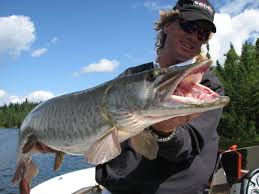

Muskie Fishing
Ontario Muskie Fishing
The Next
Bite
Ontario Fishing Trips
|
 Releasing
Muskies and HEAT Releasing
Muskies and HEAT
by Pete Maina
This is topic that I really wanted to cover. The
excessive heat experienced throughout the
country this summer has spawned a lot of
discussion among muskie anglers (and anglers of
other species as well) regarding the mortality
of big fish released in high temps and rough
conditions.
If you’ve read any of my works over the years,
you know … and may bored with it by now – of my
stressing the basics. One thing I’ve mentioned,
that has also been stated by fisheries experts
Michael Butler and Rod Ramsell, is that the
“stressors” to fish during release are additive.
For instance, let’s say a fish was hooked
deeply, requiring hook-cutting and was a little
tangled in the net, had a minor tear in a gill
arch from a hook while twisting, some slime
wiped off from angler’s clothing during hold for
a photo, was out of the water for about 45
seconds for that photo and then had to deal with
flopping around in waves (wind and big water)
while angler attempts to revive her over the
side of the boat. It happens like this quite
often really.
 It’s likely that none of these factors alone
would result in mortality. But they are
additive, and if one thing goes really wrong, or
a bunch of “little” things go wrong, often, it
will result in immediate or delayed mortality.
The one huge additive factor is time. Minimizing
the time the fish is in possession is huge. The
“time” of the fight is a big factor. We don’t
want the fish totally exhausted before the
release process starts (and that’s why lighter
tackle, for sport, is not recommended for muskie
angling). And there can be extra time getting
hooks out (cutters are “quicker”), getting
cameras ready, getting a hold, holding … time
adds up (odd, but I seem to notice this more
with age).
It’s likely that none of these factors alone
would result in mortality. But they are
additive, and if one thing goes really wrong, or
a bunch of “little” things go wrong, often, it
will result in immediate or delayed mortality.
The one huge additive factor is time. Minimizing
the time the fish is in possession is huge. The
“time” of the fight is a big factor. We don’t
want the fish totally exhausted before the
release process starts (and that’s why lighter
tackle, for sport, is not recommended for muskie
angling). And there can be extra time getting
hooks out (cutters are “quicker”), getting
cameras ready, getting a hold, holding … time
adds up (odd, but I seem to notice this more
with age).
Heat, or water temperature, is the other basic,
but very important factor I’ve mentioned often.
Now, I’m thinking it deserves even more emphasis
than I’ve given it. A couple things have
happened in the past that have me thinking of
this now, mainly that we have had such a hot
summer – one that pushed surface temperatures
into the 80’s (extended periods) which is simply
not common here in the northern latitudes.
The heat this summer has been talked about quite
a bit amongst muskie-folk – on the phone
certainly, and on website forums and social
media. The reason it came up a lot, is because
people were having some bad experiences. Oh, it
stays somewhat “hush, hush” as no one enjoys it
really – or really wants to talk about having a
questionable release or a definite loss of a
fish. But that’s the reason it comes up when the
water gets hot. Fish die … some barely swim away
… and conscientious anglers wonder.
I become more convinced every year that the
water temperature factor is huge! In the
“example” I provided above – add to that
scenario – water surface temperatures 75 degrees
or higher. Nothing absolutely certain, but
“very” good odds that fish doesn’t survive. Take
the same scenario with 60 degree or less in
surface temperature and the fish very likely
survives. And, take the same scenario with 45
degree temperatures and (no excuse to delay
things) frankly; I’d be completely unconcerned
for the fish even if there was nearly a minute
out of water.
That’s my honest take these days. It’s based on
my personal experiences and that of others I
speak with.
Here’s a key example of where my own experience
has come from: It was the summer of 1995. I was
still guiding in those days, and was booked
heavily. It was a miserable deal all the way
around for me. There were several fairly long
periods where the surface temperatures were in
the low 80’s. Of course the fishing wasn’t
great. Lots of time after dark, uncomfortable
more often than not … few fish caught
comparatively. But frankly, that was the good
news.
Long story short, I kept guiding because I was
booked and I wanted/needed the money. While I
only know for certain that one fish died (after
“long” revival, fish finally swam away … wind
remained absent … as I drove by with new clients
the next day – there it was, floating), I expect
there were more. You could simply tell by the
way the fish were reacting and “looking” in
general at the end of a fight and release. Not
good. For my clients, I was desperate to get
some action … but then when we finally hooked
one, I was secretly hoping it would wiggle-off
at boat side.
While obviously the best thing to do, would have
been to have quit fishing, I did find myself
adopting a no-photo (unless in-water) policy
with clients. I’d warn them prior, and if they
agreed we’d go (to folks’ credit, I recall no
one canceling a trip). I was very glad when it
(heat) was over.
I’m guessing there have been similar effects
this summer. For esox anglers, the lines are
gray, but as water temperatures climb into the
mid seventy degree range and beyond, if angling,
I believe that a barbless hook policy with no
lifting from the water – to be the most
responsible way to handle release under these
conditions. Minimize any time and handling
stressors. And, boy, if it gets in the eighties,
it’s time to consider not fishing.
There have been many cases where it seems
anglers will ignore “common sense” (I know I
have. And I try not to these days). My plea here
is that we re-accept the basic principles and
values of common sense – as they apply to
fisheries and life.
Editors Note:
If you have questions or comments on this or
other articles of mine you may have read,
contact me through the website
www.thenextbite.com
Check out Petes Podcasts here!
|